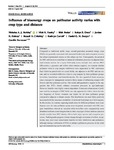Influence of bioenergy crops on pollinator activity varies with crop type and distance
| dc.contributor.author | Berkley, N | |
| dc.contributor.author | Hanley, M | |
| dc.contributor.author | Boden, R | |
| dc.contributor.author | Owen, R | |
| dc.contributor.author | Holmes, J | |
| dc.contributor.author | Critchley, R | |
| dc.contributor.author | Carroll, K | |
| dc.contributor.author | Sawyer, D | |
| dc.contributor.author | Parmesan, C | |
| dc.date.accessioned | 2018-10-05T11:25:41Z | |
| dc.date.issued | 2018-12 | |
| dc.identifier.issn | 1757-1707 | |
| dc.identifier.issn | 1757-1707 | |
| dc.identifier.uri | http://hdl.handle.net/10026.1/12461 | |
| dc.description.abstract |
<jats:title>Abstract</jats:title><jats:p>Compared to traditional arable crops, second‐generation perennial energy crops (PECs) are generally associated with increased biodiversity and ecosystem services, but robust experimental studies on this subject are few. Consequently, the potential for PEC cultivation to contribute to enhanced pollination processes in adjacent farmland remains unclear. In a 4‐year field study across multiple sites and two PECs (<jats:italic>Miscanthus x giganteus</jats:italic> and willow short‐rotation coppice), we examine whether pollinator visits to crop margin wildflowers were augmented by PEC cultivation. Each field was paired with two cereal fields, one adjacent to the PEC and one distant, and we recorded wildflower visits to crop margins by three pollinator groups: hoverflies, bumblebees and butterflies/moths. We also quantified floral resources, since crop‐specific management seemed a likely means of influencing margin wildflowers and thus pollinator activity. Our results add quantitative support to the suggestion that PECs should enhance ecosystem processes in agri‐landscapes. However, benefits were highly context‐dependent. Consistent enhancement of pollinator activity in margins of PEC fields was only apparent for willow where the relative frequency of flower visitation was higher for all three pollinator groups compared to adjacent or distant cereals. This distribution was most likely positively associated with the increased availability of preferred food plants in willow margins. In <jats:italic>Miscanthus</jats:italic>, by contrast, opposing trends arose for different pollinator taxa: Lepidoptera were the only pollinator group more frequently associated with PEC margins; bumblebees showed no variation while hoverflies were comparatively more abundant in distant cereal margins than in other crop types. Future land‐use practices should consider how PEC identity affects both target species and ecosystem processes. Tackling anthropogenic climate change through cultivation of willow, in particular, may yield local conservation benefits for both wildflowers and pollinators, although strategic cultivation of PECs to enhance pollination processes in the wider agri‐environment may not be achievable.</jats:p> | |
| dc.format.extent | 960-971 | |
| dc.language | en | |
| dc.language.iso | en | |
| dc.publisher | Wiley Open Access | |
| dc.subject | agriculture | |
| dc.subject | biodiversity | |
| dc.subject | bioenergy | |
| dc.subject | biofuel | |
| dc.subject | conservation | |
| dc.subject | Miscanthus | |
| dc.subject | pollination | |
| dc.subject | willow short-rotation coppice | |
| dc.title | Influence of bioenergy crops on pollinator activity varies with crop type and distance | |
| dc.type | journal-article | |
| dc.type | Article | |
| plymouth.author-url | https://www.webofscience.com/api/gateway?GWVersion=2&SrcApp=PARTNER_APP&SrcAuth=LinksAMR&KeyUT=WOS:000449495600004&DestLinkType=FullRecord&DestApp=ALL_WOS&UsrCustomerID=11bb513d99f797142bcfeffcc58ea008 | |
| plymouth.issue | 12 | |
| plymouth.volume | 10 | |
| plymouth.publication-status | Published | |
| plymouth.journal | GCB Bioenergy | |
| dc.identifier.doi | 10.1111/gcbb.12565 | |
| plymouth.organisational-group | /Plymouth | |
| plymouth.organisational-group | /Plymouth/Faculty of Science and Engineering | |
| plymouth.organisational-group | /Plymouth/Faculty of Science and Engineering/School of Biological and Marine Sciences | |
| plymouth.organisational-group | /Plymouth/REF 2021 Researchers by UoA | |
| plymouth.organisational-group | /Plymouth/REF 2021 Researchers by UoA/UoA06 Agriculture, Veterinary and Food Science | |
| plymouth.organisational-group | /Plymouth/REF 2021 Researchers by UoA/UoA07 Earth Systems and Environmental Sciences | |
| plymouth.organisational-group | /Plymouth/Users by role | |
| plymouth.organisational-group | /Plymouth/Users by role/Academics | |
| dcterms.dateAccepted | 2018-07-24 | |
| dc.rights.embargodate | 2019-12-7 | |
| dc.identifier.eissn | 1757-1707 | |
| dc.rights.embargoperiod | Not known | |
| rioxxterms.versionofrecord | 10.1111/gcbb.12565 | |
| rioxxterms.licenseref.uri | http://www.rioxx.net/licenses/all-rights-reserved | |
| rioxxterms.licenseref.startdate | 2018-12 | |
| rioxxterms.type | Journal Article/Review |


